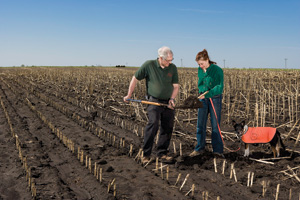Projects study best stover, grass stubble heights




January 1, 1970
BY Ron Kotrba
The USDA Agricultural Research Service's National Soil Tilth Laboratory recently completed a round of research investigating how harvest practices affect fertilizer costs and how the quality of variably harvested corn stover impacts thermochemical conversion to renewable fuel.
Corn was harvested at varying heights: high (30 inches), normal (16 inches) and low (four inches). ARS soil and water quality research leader Doug Karlen and his team found that removing stover equaled a per-acre loss of up to 45 pounds of nitrogen, two to four pounds of phosphorus and 23 to 38 pounds of potassium. In other words, low-cut harvests could cost farmers $25 to $30 per acre to replace with fertilizer.
All the stover was then thermochemically processed, and energy yields were measured. The team found the moisture content of stover adversely affected conversion efficiency the most. In fact, one of the low-cut harvests contained as much as 64 percent water. The researchers concluded the convenience, speed, water content and processing characteristics of the normal-cut stover appeared to be the all-around best option. Karlen said the cob and upper portion of the stover is best for ethanol conversion, which would likely leave ample residue behind for soil conservation. Upcoming work will look at effects of crop spacing, fertilization rates and the use of cover crops on stover quality.
Meanwhile, a South Dakota State University project is investigating how pheasant and waterfowl populations respond when perennial grasses such as switchgrass are harvested at different heights and seasons. The project recently won the 2007 Budweiser Renewable Energy and Wildlife Conservation Research Prize, which includes $100,000. SDSU assistant professor Susan Rupp said the project will study fall and spring harvest intensity. "By intensity, we're talking about removing a certain portion of the plants at different heights and then seeing what kind of an effect it's going to have on waterfowl and pheasant production," she said. "My gut instinct says that a spring harvest is going to be better, but the timing of that harvest in the spring is also going to be very essential."
Corn was harvested at varying heights: high (30 inches), normal (16 inches) and low (four inches). ARS soil and water quality research leader Doug Karlen and his team found that removing stover equaled a per-acre loss of up to 45 pounds of nitrogen, two to four pounds of phosphorus and 23 to 38 pounds of potassium. In other words, low-cut harvests could cost farmers $25 to $30 per acre to replace with fertilizer.
All the stover was then thermochemically processed, and energy yields were measured. The team found the moisture content of stover adversely affected conversion efficiency the most. In fact, one of the low-cut harvests contained as much as 64 percent water. The researchers concluded the convenience, speed, water content and processing characteristics of the normal-cut stover appeared to be the all-around best option. Karlen said the cob and upper portion of the stover is best for ethanol conversion, which would likely leave ample residue behind for soil conservation. Upcoming work will look at effects of crop spacing, fertilization rates and the use of cover crops on stover quality.
Meanwhile, a South Dakota State University project is investigating how pheasant and waterfowl populations respond when perennial grasses such as switchgrass are harvested at different heights and seasons. The project recently won the 2007 Budweiser Renewable Energy and Wildlife Conservation Research Prize, which includes $100,000. SDSU assistant professor Susan Rupp said the project will study fall and spring harvest intensity. "By intensity, we're talking about removing a certain portion of the plants at different heights and then seeing what kind of an effect it's going to have on waterfowl and pheasant production," she said. "My gut instinct says that a spring harvest is going to be better, but the timing of that harvest in the spring is also going to be very essential."
Advertisement
Advertisement
Advertisement
Advertisement
Upcoming Events





